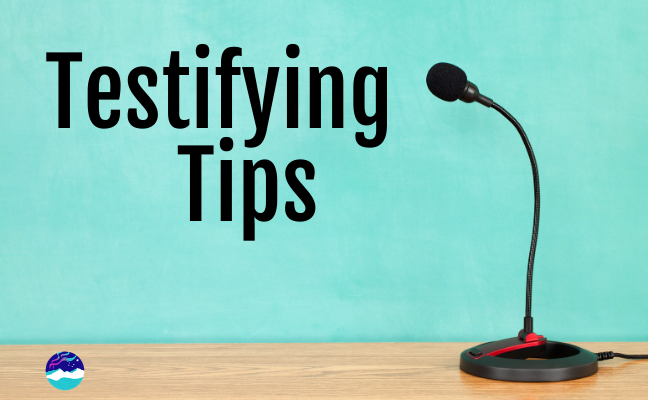
Testifying Tips
Providing testimony in person, virtually, or by phone
Testifying before a legislative committee can be intimidating, but here are a few tips to make it easier:

- Do your research. Know the bill you wish to address and prepare your testimony in advance.
- Be on time. Show up 15 minutes before the meeting.
- Sign up to testify. If you are testifying in person at the capitol, a sign-up sheet will usually be on the table at the entrance door to the committee room. If you are testifying at a regional Legislative Information Office (LIO), sign up at the LIO office.
- Mute your cell phone when entering the committee room.
- When called upon by the chair for your turn to testify. Proceed to the table and have a seat. The chair will direct you to state your name and affiliation for the record.
- Speak into the microphone, so there is a clear record of your testimony.
- Practice your testimony and time it. Testimony is typically on a time limit, so be sure that your essential points can be delivered within three (3) minutes. While the usual time is three minutes, depending on how many people the chair expects to testify, the time limit may be less. Time limits are typically posted on the “meetings” tab on the Alaska State Legislature web site.
- Introduce Yourself. Start your testimony with: “Good Morning Mr. Chair and members of the Senate Education Committee. My name is John Doe, and I’m a member of the Juneau School District Board of Education.”
- Deliver your testimony. “Shorter” is better than “longer.” Ideally, three bullet points, but no more than five, should be the extent of your testimony. Begin your testimony with your “ask.” Are you for or opposed to the bill, and why? Are you opposed to the entire bill or just one section of the bill? As you begin your testimony with the “ask,” also end it with the “ask.”
- Answering questions from committee members. When addressing the committee ALWAYS speak through the chair. When the chair asks a question, respond, “Madam/Mister Chair,” and answer the question. When a committee member asks a question, respond, “Through the Chair,” then the questioner’s name, “Senator Jones,” and answer the question.
- It’s OK if you don’t know the answer. If you don’t know the answer to a question, say you don’t know the answer, but you’ll get back to the committee with the information. Make sure to follow up and provide the information the committee has requested.
- If you have handouts, follow protocol. Do not distribute handouts directly to committee members. Instead, give them to the committee aide to distribute.
- When you finish. End with, “Ms./Mr. Chair, thank you for the opportunity to testify” and return to your seat.
- When testifying at a regional Legislative Information Office (LIO). The protocols described above are still the same, even if you are testifying remotely, not in person at the capitol.
Providing testimony by email or letter
Waiting on the telephone to be called for your time to testify can be frustrating, and most cannot take the time away from their work to provide testimony in this manner. Another option is to provide your testimony by email or letter.

- Do your research. Know the bill you wish to address and be succinct. Committees and individual legislators receive a considerable amount of correspondence and are more likely to read a single page rather than multiple pages. Cite the bill by number (HB 1 or SB 2).
- Multiple media forms are available. It is equally effective to use email or a letter. In today’s digital age, many choose to include a letter as an email attachment.
- Use the appropriate address.
- For Senators: The Honorable John Doe (or) Senator John Doe. Salutation: Dear Senator Doe.
- For Representatives: The Honorable Jane Doe (or) Representative Doe. Salutation: Dear Representative Doe.
- Legislator Email addresses.
- Senator.John.Doe@nullakleg.gov
- Representative.Jane.Doe@nullakleg.gov
- Handy Tip – “Alaska State Legislature” web page; Click on either Senate or House; click on “Current Members” in the drop-down menu; underneath the photo of the legislator click on “Email Me” and the address will appear in an email form.
- You may send the same email to multiple legislators on the same email by inserting a semicolon between each address.
- Legislative Committee Correspondence. You may send an email to a specific committee that is considering a bill you wish to testify on. The email will go to the committee aide and be distributed to each committee member.
- Ensure clarity. Begin your correspondence with your “ask.” Do you support or oppose the bill? Is it for the entire bill or a specific item within the bill? The use of bullet points is very effective for busy legislators. Three bullets points are good but never more than five. End your correspondence with the “ask” as well.
- Personalize your message. How will this legislation affect students in your district?
- Practice civility. Present a logical, civil, and reasonable tone in your correspondence. Never rail or make it a diatribe.
- Identify yourself and who you represent. “I am Mary Jones, and I serve on the Fairbanks North Star Borough Board of Education.
